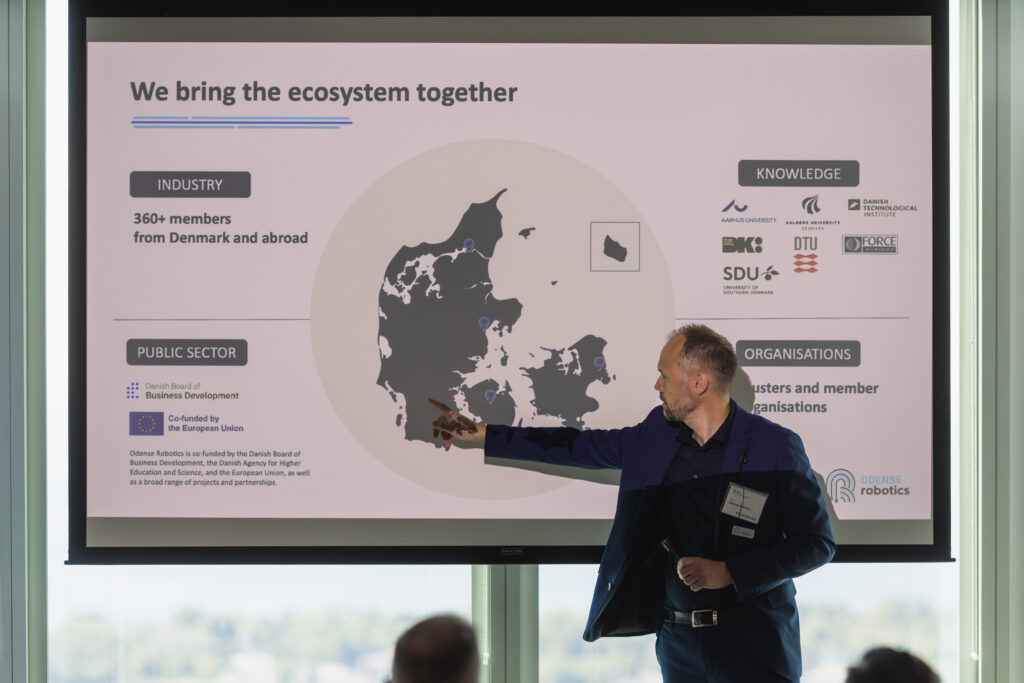This story was originally published by the University of Toronto Government Relations Office.
By Catrina Kronfli
In partnership with Next Generation Manufacturing Canada (NGen Canada), the Robotics Institute – an Institutional Strategic Initiative (ISI) at U of T – recently brought together over 160 attendees from across the country during the Canadian Robotics Council’s (CRC) third annual Symposium in Toronto.
The Council launched as a non-profit in June 2023. The association represents the voice of robotics researchers, innovators, and companies in Canada. Co-chaired by the UofT Robotics Institute ISI, the Council is helping to raise the profile of robotics and automation in Canada.
“This cross-sector gathering of Canadian decisionmakers could not be more timely,” said Hallie Siegel, Managing Director of Strategy and Partnership at the Robotics Institute and co-chair of the CRC’s Executive Committee. “Australia, the United States, China and the European Union are among the regions that have launched new robotics strategies or renewed existing frameworks,” Siegel pointed out. “This means increased competition but could also pave the way for new partnerships for robotics researchers and firms in Canada,” Siegel said.
Closer to home, Siegel noted that stakeholders have been talking about the need for collaboration across Canada’s robotics ecosystem since 2017, which is now being realized with the formation of the CRC and funding through NGen to advance the Counci’s mission. “Canadian decisionmakers from across the board – educators, researchers, small robotics startups, major manufacturers, investors, and unions – have seen the urgency and value of working together. It means we are on the right track and that is reason alone to be hopeful about Canada’s future.”

The Symposium explored a number of challenges facing Canada’s robotics sector and potential solutions that could unlock the sector’s full potential. This includes the need to:
- Develop a national robotics strategy: In their 2020 report, the Robotics Institute proposed a Canadian robotics strategy, an idea that is also being advanced by The Globe and Mail’s Rita Trichur, who covered the Symposium. This idea has gained traction given the steps other jurisdictions are taking, growing concerns around Canada’s productivity, and the emergence of Canadian strategies in other critical technology areas, namely in AI and quantum science and technology. As an enabling technology, robotics has demonstrated potential to enhance innovation and productivity in a wide range of sectors (i.e., agriculture, construction, healthcare, manufacturing, and mining), underscoring the possible economic benefits associated with developing such a strategy.
- Engage workers and provide (ongoing) training: Statistics Canada has found that firms who adopt robots tend to grow rather than shrink their workforce. And unions are ready to have a conversation on how to ensure that robots do not take jobs, but support jobs, said representatives for Unifor, one of Canada’s largest unions, at the Symposium. When workers are involved in the introduction and integration of robotics technology, they and their companies can optimize the productivity gains. Industry representatives also said they support early and continuing engagement with employees when new technology is adopted. Indeed, several companies offered examples of incomplete robotics adoption due to lack of worker consultation. To support those using robots daily, employers should invest in upskilling and re-skilling and in targeted training. Mid-career professionals are also in demand but may need upskilling to work with robots.
- Offer incentives to support domestic robotics adoption and tackle Canada’s productivity crisis: In March 2024, the Bank of Canada declared Canada’s waning productivity a ‘national emergency.’ While technology adoption is touted as a potential solution, adoption rates remain low. Barriers include the upfront costs of equipment and skills required. Numerous case studies presented at the Symposium by robotics firms demonstrated to attendees how state of the art technology has delivered a return on investment to organizations who invest. Participants suggested there is a need for policymakers to provide incentives and other measures to address challenges to bringing robotics to new industries.
- Continue cross-sectoral collaboration: In his keynote address, Søren Elmer Kristensen, CEO of Odense Robotics, explained that collaboration between academia, industry, a trade union, and local government was critical to the success of Denmark’s robotics cluster. Located in Odense, this world-leading cluster has grown over two decades to include over 500 firms that employ 12,700 people. This collaborative model is also advocated by the CRC.
“Our keynote, panels, and expert roundtables at the Symposium were deliberately designed to surface a wide range of perspectives from key decisionmakers and stakeholders on what Canada needs to advance robotics here in a way that benefits Canadians as a whole,” Siegel explained. “We look forward to working with our partners to advance their recommendations and insights in a report, expected to launch this fall.”
Since its launch, the CRC has been committed to providing policymakers with foundational data on the robotics sector to support evidence-based decision-making.
The Council’s 2022 report coupled with Avascent’s report – which was commissioned by ISED in 2020 – provided a snapshot of Ontario’s and Canada’s robotics industry, including geography, size, sector, and robot type. Notably, Avascent found that over 59% of robotics firms are in Toronto and Mississauga, meaning these cities anchor the province’s robotics cluster. In addition, Avascent found that Ontario is the most significant robotics cluster in Canada, with the most robotics academic labs and robotics firms in the country.
The CRC is currently creating an inventory of Canadian robotic assets. The Research and Training Committee is mapping robotics training opportunities and researchers across the country, while the Government Coordination Committee is identifying government agencies who are focused on robotics. Their goal is to develop an interactive tool to improve public awareness of government activities in the field and foster greater intergovernmental collaboration.